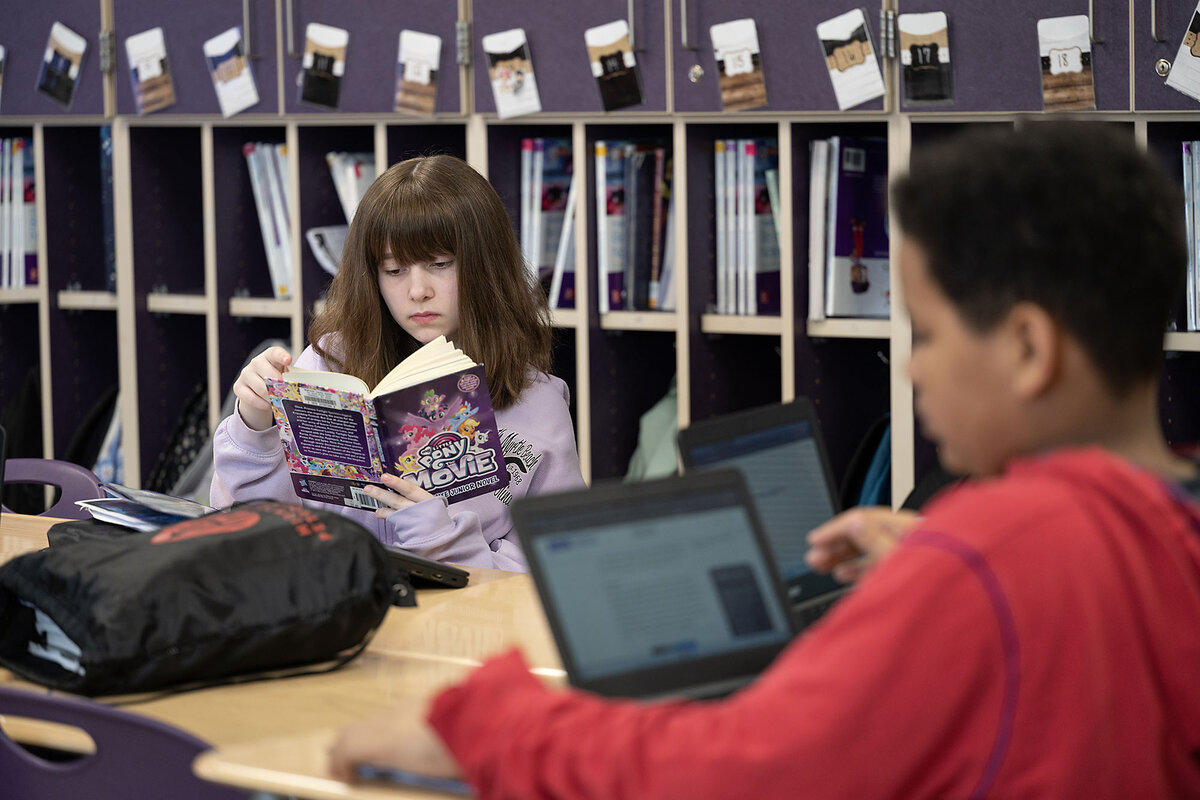‘It doesn’t have to be scary.’ How to get students to love reading.
Loading...
Alden Jones reached a point this summer when she needed to share her thoughts with the world.
She brought her observations to X. Her post went viral, likely due to her eye-catching first line: “Yes, college students have lost their ability to read.”
Ms. Jones, an assistant professor of writing, literature, and publishing at Emerson College in Boston, says reading hesitancy among her young adult students started in the late 2000s and accelerated during the pandemic. During that period, she even noticed her own attention span for books diminishing.
Why We Wrote This
A story focused onA professor’s lament on social media about her college students got us thinking about the best way to encourage the joys of reading. To find out more, we asked the experts: teachers.
The difficult part, she says, is simply engaging students in reading – whether it be of short stories, essays, poems, or novels.
“It’s not that they can’t analyze a sentence,” Ms. Jones says. “It’s that they can’t turn their minds fully to the material in the way that [people] used to.”
So what’s the trick to getting young people – and teens and 10-year-olds – to enjoy the act of reading? To stay in the moment long enough to appreciate the feel of paper pages and a cliff-hanger chapter? What can parents and teachers do?
Educators the Monitor reached out to as the school year gears up have lots of advice: Set aside dedicated time for reading. Find materials that resonate with students. Offer a welcoming setting. Give students the chance to talk about what they’ve read.
“What are they liking about it? What are they not liking about it? What surprised them?” says Patricia Durham, a literacy professor at Sam Houston State University, suggesting questions to spark discussion.
Many of these strategies largely revolve around building joy rather than drudgery. The depth of students’ reading challenges have supercharged debate and policy decisions about how best to teach the subject. But some educators and experts are also raising concern that pleasure reading shouldn’t fall at the sword of rigorous phonics, vocabulary, and comprehension instruction. In other words, both matter.
Antoine Edwards, a seventh grade English language arts teacher at Sutton Middle School in Atlanta, views confidence-building as an important first step. He starts the school year with shorter stories – or as he puts it, “texts that aren’t intimidating” – and develops a respectful classroom culture. The presence of a big, comfy couch helps, too.
“The classroom is inviting,” he says. “So they’ll feel comfortable, and it doesn’t have to be scary.”
Mr. Edwards also devotes time to First Chapter Fridays. Each week, he reads aloud the first chapter of a new book, hoping to spark interest among his middle schoolers. A recent title in that rotation: “On the Come Up” by Angie Thomas.
Where teens got to choose new books for their library
Halfway across the United States, leaders at Roosevelt High School in Des Moines, Iowa, recently took a slightly different approach: They invited a group of 20-plus students to help select new books as part of a $1.2 million library renovation project.
Comfort Toluwalase, a junior, says she took the opportunity seriously and wanted to find books that would have a “lasting impact” on her classmates. She recalls reading “The House on Mango Street,” by Sandra Cisneros, in eighth grade and feeling kinship with the main character, who grew up in a lower-income neighborhood.
Now an avid reader of science fiction and fantasy books, Comfort once hated reading. “I think reading books was kind of like a way to escape from some things that were stressful,” she says.
Comfort and Sha’nye Kinchelow, a sophomore on the selection committee, also say they prioritized books featuring diverse authors and characters.
“We’re all different in our ways, but we just need to learn to accept it,” says Sha’nye, who was particularly excited about books examining African American and Latino history. “So I feel like the books will actually help us understand that.”
Principal Steve Schappaugh says motivation is key, especially in an era defined by lack of reading stamina. Social media has programmed students to digest short, concise blurbs, he says. And though that’s valuable, educators are constantly trying to build students’ reading muscles for longer forms of writing.
Will the expanded library collection and refreshed vibe – complete with artwork, conference rooms, and cozy nooks – help?
“I saw students today looking at books that I have not seen looking at books in the previous years they were at our school,” he says by phone earlier this month.
What do parents think their children should read?
In Temple, Texas, kindergarten teacher JoMeka Gray starts each year by surveying parents. She wants to learn her students’ interests so she can find reading materials about dinosaurs, plants, baseball, or any other topic that fires their imagination.
Ms. Gray, who teaches at Kennedy-Powell STEM Academy, has also been leaning into what she describes as “predictive texts.” She points to “Whose Teeth Are These?” – written by Kris Hirschmann and illustrated by Daniel Howarth – as an example of a children’s book that is interactive and educational.
“It seems like it’s fiction, but it’s really teaching them,” she says.
Like a gym, a dedicated reading space offers motivation
Back in Boston, Ms. Jones’ strategies to overcome college student roadblocks include balancing shorter and longer stories, strongly encouraging paper texts, reading aloud in class, keeping reading assignments reasonable, and giving comprehension quizzes. If students enjoy – and complete – the reading, she says, the quality of class discussions inevitably improves.
But Ms. Jones doesn’t want that engagement to end at her classroom door. She may launch “reading hours” on campus, in which students can cozy up to a good book, poem, or other form of the written word. Her rationale: Some people can’t muster the motivation to exercise at home. Maybe a dedicated reading space would renew their interest, away from distractions, much like a gym or workout class.
The concept, she suspects, may even lend itself to camaraderie and friendly discussions.
“It’s enjoyable and interesting to talk about what’s in the book,” she says. “And it’s not about the stress of a class.”
Editor's Note: This story has been updated to correct the name of Emerson College in Boston.








